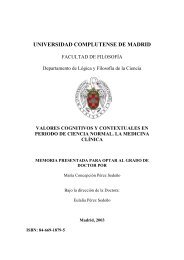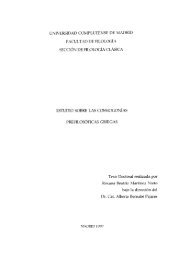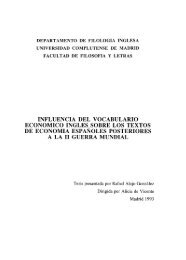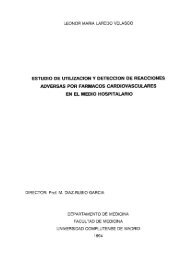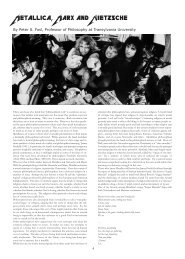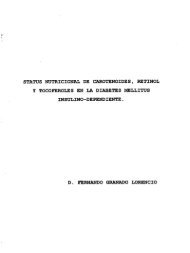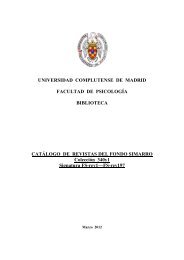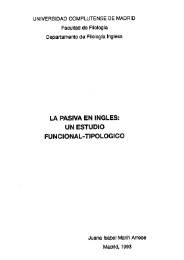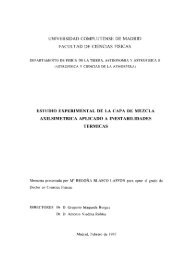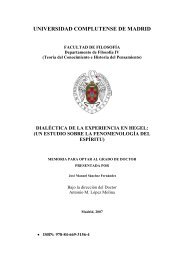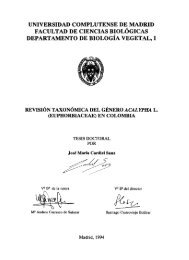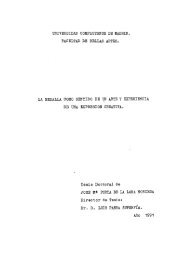- Page 1 and 2: ABRIR 3.2. La adolescencia
- Page 3 and 4: Ficción y Realidad en la obra de T
- Page 5 and 6: flcción y Realidad en la obra de T
- Page 7 and 8: Ficción y Realidad en la obra de T
- Page 9: Ficción yRealidad en la obra de Tr
- Page 13 and 14: Ficción y Realidad en la obra de 7
- Page 15 and 16: Ficción y cli la obra de frunzan C
- Page 17 and 18: Ficción y Realidad en la obra de T
- Page 19 and 20: 3.3.1. Breakfast al Tiftánv’s (1
- Page 21 and 22: Ficción y Realidad en la obra de T
- Page 23 and 24: Ficción yRealidad en la obra de Tn
- Page 25 and 26: Ficción yRealidad en la obra de Tr
- Page 27 and 28: Ficción y Realidad en la obra de T
- Page 29 and 30: Ficción y Realidad en la obra de T
- Page 31: Ficción y Realidad en la obra de T
- Page 34 and 35: Ficción yRealidad en la obra de Tr
- Page 36 and 37: Ficción y Realidad en la obra de T
- Page 38 and 39: Ficción y Realidad en la obro de T
- Page 40 and 41: Ficción y Realidad en la obra de f
- Page 42 and 43: Ficción y Realidad en la ob,a de T
- Page 44 and 45: Ficción y Realidad en la obra de T
- Page 46 and 47: Ficción y Realidad en la obra de T
- Page 48 and 49: Ficción y Realidad en la obra de T
- Page 50 and 51: “1 ‘m a drug addici, 1 ‘ni a/
- Page 52 and 53: Ficción y Realidad en la obra de T
- Page 54 and 55: 3.3.2. AnsweredPravers (1987 Ficci
- Page 57 and 58: Ficción y Realidad en la obra de T
- Page 59 and 60: Ficción y Realidad en la obra de T
- Page 61 and 62:
Ficción yRealidad en la obra de Tr
- Page 63 and 64:
Ficción yRealidad en la obra de Tr
- Page 65 and 66:
Ficción y Realidad en la obra de T
- Page 67 and 68:
Ficción y Realidad en la obra de T
- Page 69 and 70:
Ficción yRealidad en la obra de Tr
- Page 71 and 72:
Ficción yRealidad en la oIna de Tr
- Page 73 and 74:
Ficción y Realidad en la obra de T
- Page 75 and 76:
3.3.3. Local Color (1950 Ficción y
- Page 77 and 78:
Ficción i’Realidad en la obra de
- Page 79 and 80:
Ficción y Realidad en la obra de F
- Page 81 and 82:
Ficción y Realidad en la obra de T
- Page 83:
Ficción y Real,dad en la obra de F
- Page 87 and 88:
Ficción y Realidad en la obra de I
- Page 89 and 90:
3.3.4. A Beaut1/id Chtid (1979 Ficc
- Page 91 and 92:
Ficción y Realidad en la abra de T
- Page 93 and 94:
Ficción y Realidad en la obra de T
- Page 95 and 96:
Ficción y Realidad en la obra de T
- Page 97 and 98:
Ficción y Realidad en la obra de T
- Page 99 and 100:
Fzcción y Realidad en la abra de T
- Page 101 and 102:
Ficción y Realidad en la obra de T
- Page 103 and 104:
Ficción y Realidad en la obra de T
- Page 105 and 106:
Ficción y Realidad en la obra de T
- Page 107 and 108:
Ficción y Realidad en la obra de T
- Page 109 and 110:
Ficción Realidad en la obra de Tru
- Page 111:
FYcci¿5n y Realidad en la obra de
- Page 114:
Fwcián y Realidad en la obra de Tn
- Page 117 and 118:
Mccíón y Realidad en la obra de T
- Page 119 and 120:
Ficción y Realidad en la obra de T
- Page 121 and 122:
Ficción y Realidad en la obra de 7
- Page 123 and 124:
Ficción y Realidad en la obra de T
- Page 125 and 126:
Ficción y Realidad en la obra de T
- Page 127 and 128:
Ficción y Realidad en la abra de T
- Page 129 and 130:
Ficción y Realidad en/a obra de Tr
- Page 131 and 132:
Ficción y Realidad en la obra de T
- Page 133 and 134:
Ficción y Realidad en la obra de T
- Page 135 and 136:
Ficción y Realidad en la obra de T
- Page 137 and 138:
Ftcción yRealidad en la obra de Tr
- Page 139 and 140:
Ficción y Realidad en la obra de T
- Page 141 and 142:
Ficción y Realidaden la obra de Tr
- Page 143 and 144:
Ficción y Realidad en la obra de T
- Page 145 and 146:
Ficción y Realidad en la obra de 7
- Page 147 and 148:
Ficción y Realidad en la abra de T
- Page 149 and 150:
Ficción y Realidad en la obra de T
- Page 151 and 152:
Ficción y Realidad en la obro de T
- Page 153 and 154:
Ficción y Realidad en la obra de T
- Page 155 and 156:
Ficción y Realidad an la abra de T
- Page 157 and 158:
afirmar que Ficción y Realidad en
- Page 159 and 160:
Ficción y Realidad en la obra de T
- Page 161 and 162:
Ficción y Realidad en la obra de T
- Page 163 and 164:
Ficción y Realidad en la obra de T
- Page 165 and 166:
Ficción yRealidad en la obra de Tr
- Page 167 and 168:
Ficción y Realidad en la obra de T
- Page 169 and 170:
Ficción y Realidad en la obra de T
- Page 171 and 172:
Ficción y Realidad en la obra de T
- Page 173 and 174:
Ficción y Realidad en la obra de T
- Page 175 and 176:
Ficción y Realidad en la obra de T
- Page 177 and 178:
least. Ficción yRealidad en la obr
- Page 179 and 180:
Ficción y Realidad en la obra de T
- Page 181 and 182:
Ficción y Realidad en la obra de T
- Page 183 and 184:
Ficción y Realidad en la obra de T
- Page 185 and 186:
Ficción y Realidad en la obra de T
- Page 187:
TC: Good Night. TC: Good Night. TC:
- Page 190 and 191:
Ficción y Realidad en la obra de T
- Page 192 and 193:
Ficción y Realidad en la obra de T
- Page 194 and 195:
Ficción y Realidad en la obra de T
- Page 196 and 197:
Ficción yRealidad en la obra de Tr
- Page 198 and 199:
4. Conclusión Ficción y Realidad
- Page 200 and 201:
Ficción y Realidad en la obra de T
- Page 202 and 203:
Ficción y Realidad en la obra de T
- Page 204 and 205:
Ficción y Realidad en la obra de T
- Page 206 and 207:
£ BIBLIOGRAFÍA Ficción yRealidad
- Page 208 and 209:
Ficción y Realidad en la obra de T
- Page 210 and 211:
Ficción y Realidad en la obra de T
- Page 212 and 213:
5.1.2. Otras ediciones consultadas
- Page 214 and 215:
Ficción y Realidad en la obra de T
- Page 216 and 217:
Ficción y Realidad en la obra de T
- Page 218 and 219:
Ficción yRealidad en la obra de 7r
- Page 220 and 221:
Ficción y Realidad en la obra de T
- Page 222 and 223:
5.1.5. Obras sobre la vida del auto
- Page 224 and 225:
5.2. RIENTES SECUNDARIAS 5.2.1 Estu
- Page 226 and 227:
Ficción y Realidad en la obra de T
- Page 228 and 229:
Ficción y Realidad en la obra de P
- Page 230 and 231:
Ficción y Realidad en la obra de T
- Page 232 and 233:
5.3. BJBLJOCJRAFÍA GENERAL Ficció
- Page 234 and 235:
Ficción y Realidad anta obra de
- Page 236 and 237:
Ficción y Realidad en la obra de T
- Page 238 and 239:
Ficción y Realidad en la obra de f
- Page 240 and 241:
Ficción y Realidad e,, la otra de
- Page 242 and 243:
Ficción y Realidad en la obra de T
- Page 244 and 245:
Ficción y Realidad en la obra de T
- Page 246 and 247:
Ficción y Realidad en la obra de T
- Page 248 and 249:
Ficción y Realidad en la obra de T
- Page 250 and 251:
‘[ANNER, Tony. City of Wort!& Lon
- Page 252:
Ficción y Realidad en la obra de T



